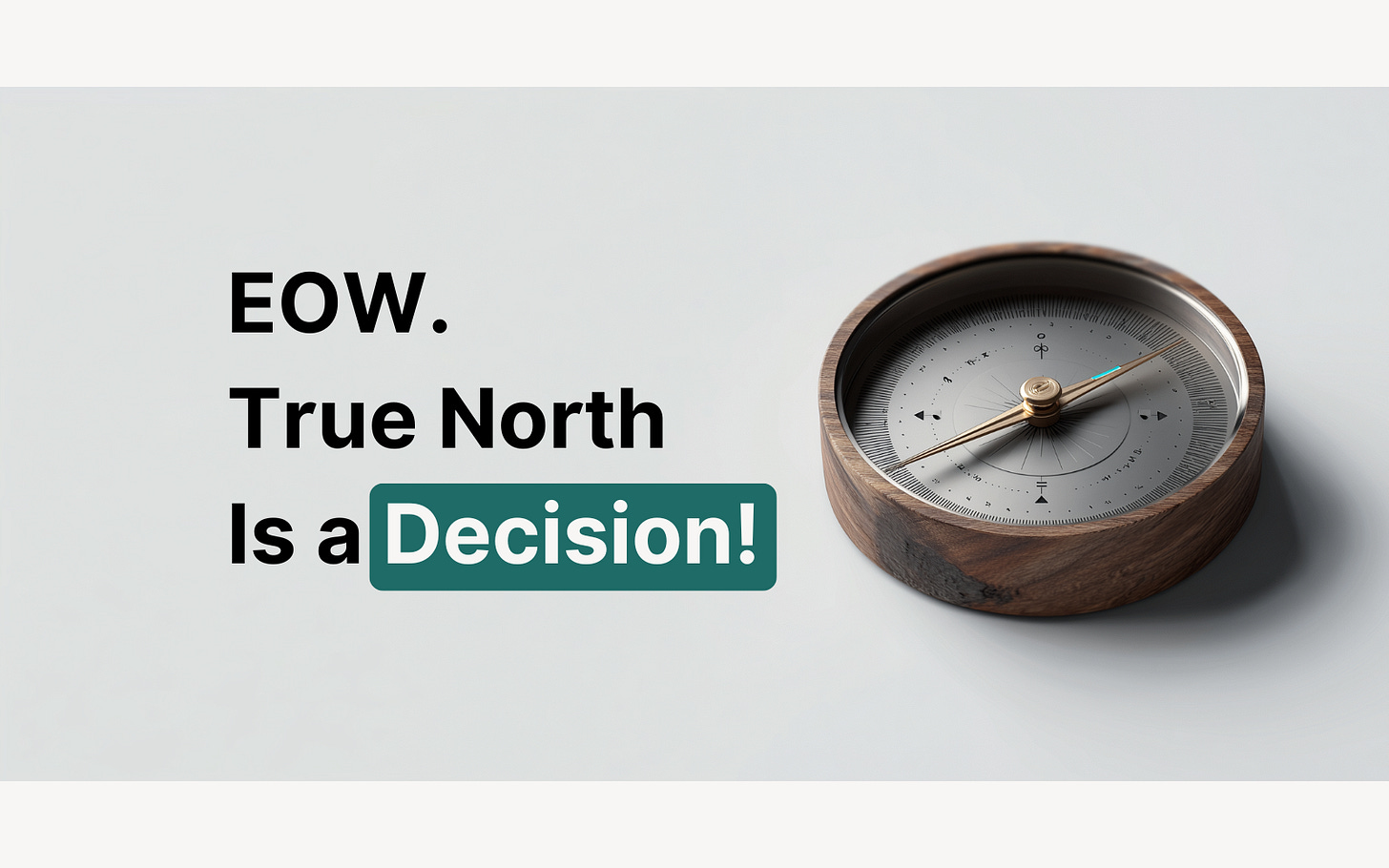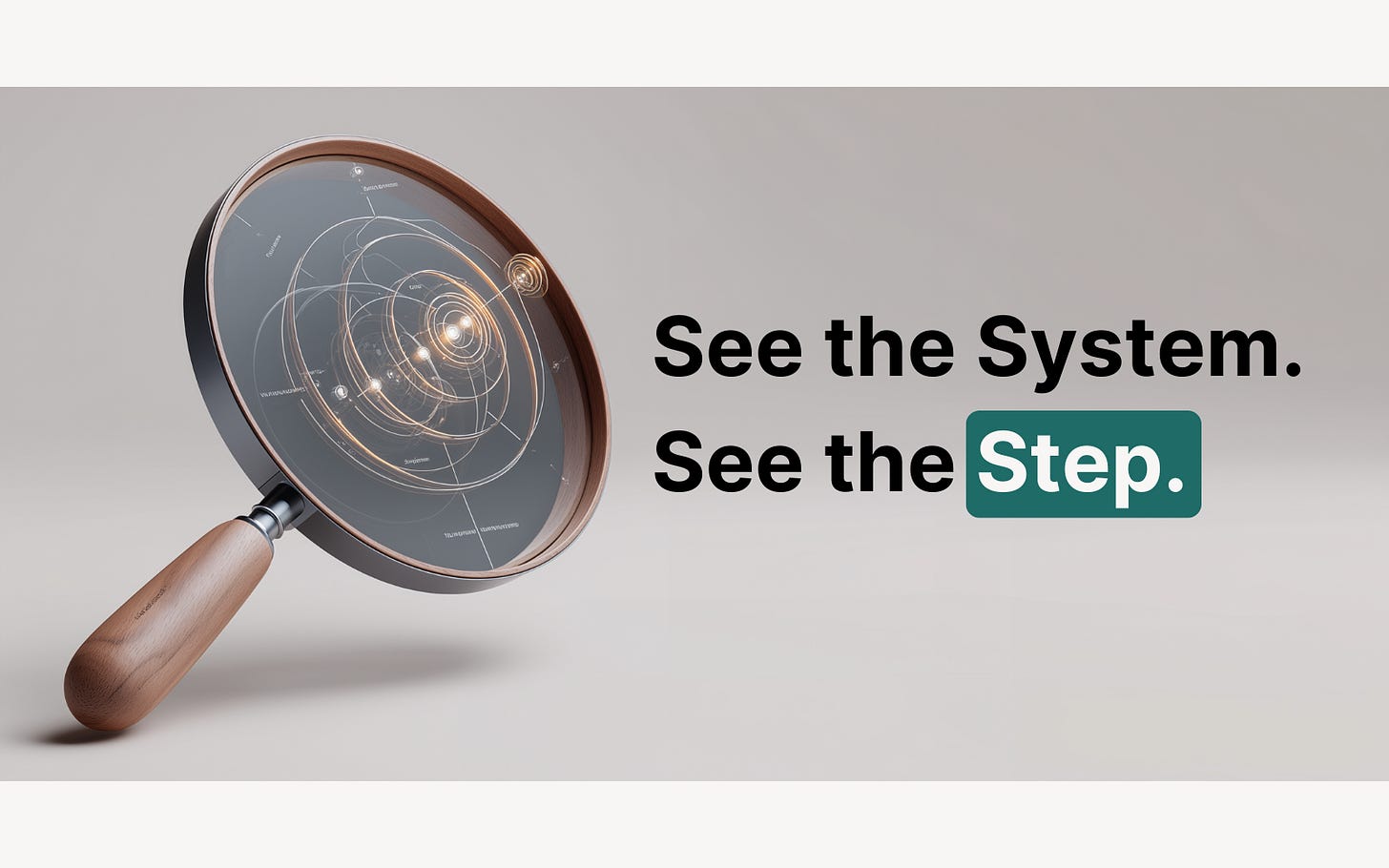Outlearn Your Rivals: The Navigator OS That Turns Plans Into Power
Use the EOX loop to compress strategy cycles from weeks to minutes—and keep your plan a hypothesis, not a contract.
Install the Navigator OS: Run your company on EOD→EOW→EOQ loops instead of static quarterly plans.
Compress strategy cycles: Use an AI Partner to turn weeks-long debates into minutes-long simulations.
Ritualize alignment: Adopt the EOQ Review to keep your plan as a hypothesis, not a contract.
In the next five years, a new breed of AI-native company will not just out-maneuver incumbents; they will make their entire operating model obsolete. The weapon they’ll use isn’t a better product. It’s a superior nervous system—a fundamentally different way of making decisions. For this new breed of company, the process is the product. Their ability to learn, align, and adapt with speed is their most valuable asset, and it’s this capability that will turn even the most well-laid quarterly plans into a source of strategic drag.
From Rigid Maps to a Living Nervous System
To understand why, we first have to recognize a familiar pattern, not just in others, but in ourselves. Let’s call it the "Map Maker Mindset." This isn't about using an outdated methodology; it's a cognitive trap that can afflict even the most agile teams. It's the quiet, seductive belief that once we've set our quarterly OKRs or sprint goals, the thinking part is over and the execution part begins. It’s the subtle shift from treating a plan as a hypothesis to treating it as a contract.
This mindset has a single, fatal design flaw: it lengthens the feedback loop between strategic assumption and real-world validation. When a plan becomes a contract, any deviation feels like a failure, not a discovery. This creates a dangerous hesitation to adapt, even when new data is telling us to change course. We’ve all seen the symptoms: Nokia had a deeply held conviction in a hardware-centric world while the iPhone was proving that software was the new continent. Kodak saw the digital tidal wave coming, but their commitment to the existing plan made them too slow to turn the ship.
These companies were not undone by a lack of planning, but by a process that lacked the capacity for rapid, high-integrity course correction. To thrive in today's market, a new approach is required.
The Navigator's Advantage: Compressing Time with an AI Partner
To escape the Map Maker's trap, a new archetype must emerge: The Navigator. Unlike the leader who is locked into their initial plan, the Navigator treats their plan as a starting hypothesis. Their superpower isn't a better crystal ball; it's a superior system for learning and adapting faster than the environment changes. They are not reactive; they are proactively adaptive, constantly seeking new data to refine their course.
This philosophy is the embodiment of a core value from our Mirror Manifesto: Continuous Flow Over Rigid Plans. This isn't a call for chaos. It’s about creating a structured, rhythmic feedback loop that enables constant, intelligent adaptation. It’s the belief that the health of a company is measured not by its adherence to a plan, but by the speed and quality of its course corrections.
The EOX Zoom Lens
The engine that powers this philosophy is our EOX (End-of-X) System—an AI-first model for strategic execution. Without a true AI Partner that has shared context from your entire day, the overhead would be crushing. But with one, the synthesis of the daily log becomes a one-minute act of confirmation, not a half-hour act of recollection. The AI handles the immense work of synthesis and analysis, turning strategy from a static document into a living, breathing process.
Our EOX is a hierarchical "zoom lens" connecting strategy to execution:
EOP (End-of-Pivot): Responding to existential strategic shifts.
EOY (End-of-Year): Setting long-term direction and major bets.
EOQ (End-of-Quarter): The operating plan and live scorecard.
EOW (End-of-Week): The rhythm of alignment and course-correction.
EOD (End-of-Day): Turning raw signals into shared memory.
Plan → Monitor → Log
This is possible because our EOX documents are not mere reports; they are dynamic assets with a three-phase lifecycle. Before a quarter begins, the EOQ is The Plan. During the quarter, it becomes The Live Monitor. After the quarter ends, it transforms into The Historical Log. The EOX system effectively writes the story of a company while it's living it.
We believe so strongly in this model that we've already open-sourced the foundational layers. You can explore our protocols for the Daily Sync (EOD) and the Weekly Review (EOW) in our previous articles.
The System Under Pressure: A Real-World Pivot
To see how this operating system moves from theory to practice, let's examine a high-stakes pivot we executed last quarter.
We celebrated a major technical breakthrough: the architectural design for our V8 AI Agent. On paper, it was a massive win. Our first reaction was pride. The V8 design was elegant, and we were excited about the plan. But as we stress-tested the design, our own EOW report surfaced a conflicting signal.
Great engine, no fuel: The data was clear that the agent's primary limitation was no longer its reasoning but the friction of manually providing it with context.
The Map Maker Mindset would have dictated that we log this as tech debt and stick to the plan. But the Navigator mindset forced us to ask a harder question: "Is solving this context problem now more important than our currently planned work? Can we afford the pivot?"
This is where having an AI Partner, which we conceptualize as an "AI First Officer," becomes indispensable. An AI First Officer is an always-on analyst with shared company context. Its inputs are your EOD logs, velocity metrics, and backlog; its outputs are scenario forecasts and trade-off analyses. The human Navigator makes the final call.
We tasked ours to run a new scenario:
Model the impact of prioritizing a new "Agent Modes" epic—a feature designed to let our agent pull context from different sources—against our validated Q3 velocity.
Project the trade-offs and new completion dates for our other goals.
At 14:20, we had the forecast. By 14:35, we had re-prioritized the sprint. We changed course with confidence, cutting our time-to-decision from days to minutes, armed with data, not just a hunch.
Your First Steps as a Navigator
You can begin installing this mindset today. It doesn’t require a massive re-org, just a shift in rituals.
EOD (5 min): At the end of each day, simply capture your outcomes, blockers, and surprises in a simple log.
EOW (30 min): At the end of the week, review the daily logs. Ask: what was the biggest surprise? What did we learn that might challenge our plan?
Start the question: In your next team meeting, ask: "What is one assumption in our current plan that new data might be challenging?" The discussion that follows is your first act as a Navigator.
Your New Competitive Advantage: An Adaptive Flywheel
The competitive battle of the next decade will be won by companies that possess the fastest, most intelligent feedback loop. Why? Because AI is rapidly commoditizing knowledge work and tactical execution. The long-term advantage will no longer be what you know or even how fast a single employee can execute a task. The defining factor will be organizational alignment and the speed at which the entire company can adapt as one.
This speed isn't about chaos. It's about having a stable, long-term vision and using a symbiotic partnership with an AI to constantly run micro-simulations that find the most effective path to that unchanging destination. While your competitors are stuck debating whether to deviate from their Q3 plan, you'll have already pivoted, captured the opportunity, and be three steps ahead.
It’s a fundamental shift. Stop asking, "Is everyone sticking to the plan?" and start asking, "Is our entire company aligned on the most valuable path right now?" The former breeds rigidity; the latter builds dynasties.
Achieving this level of dynamic alignment requires a new strategic ritual. On Friday, August 15, 2025, we will open-source the EOQ Review—the protocol we use to synthesize a quarter's worth of data into a single source of truth that aligns our entire company. Subscribe to get the blueprint and full walkthrough.






